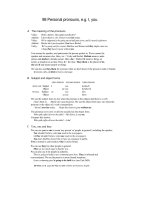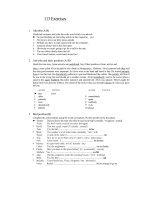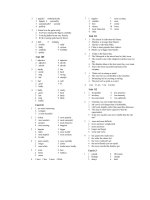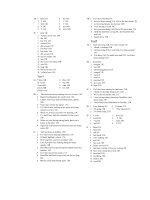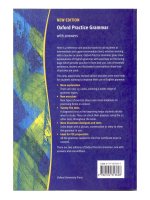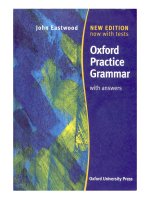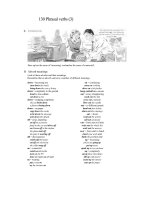Oxford practice grammar with answers part 1 ppsx
Bạn đang xem bản rút gọn của tài liệu. Xem và tải ngay bản đầy đủ của tài liệu tại đây (414.15 KB, 10 trang )
Second edition
Oxford
Practice
Grammar
with answers John Eastwood
Oxford University Press
Oxford University Press
Great Clarendon Street, Oxford OX2 6DP
Oxford New York
Auckland Bangkok Buenos Aires Cape Town Chennai
Dar es Salaam Delhi Hong Kong Istanbul Karachi
Kolkata Kuala Lumpur Madrid Melbourne Mexico
City Mumbai Nairobi Sao Paulo Shanghai Singapore
Taipei Tokyo Toronto
with an associated company in Berlin
Oxford and Oxford English
are trade marks of Oxford University Press.
ISBN 0 19 431369 7 (with answers)
ISBN 0 19 431427 8 (with answers with CD-ROM)
ISBN 0 19 431370 0 (without answers)
© Oxford University Press 1992, 1999
First published 1992 (reprinted nine times)
Second edition 1999
Tenth impression 2002
Printing ref. (last digit): 6 5 4 3 2 1
No unauthorized photocopying
All rights reserved. No part of this publication may be
reproduced, stored in a retrieval system, or transmitted,
in any form or by any means, electronic, mechanical,
photocopying, recording or otherwise, without the prior
written permission of Oxford University Press.
This book is sold subject to the condition that it shall
not, by way of trade or otherwise, be lent, resold, hired
out, or otherwise circulated without the publisher's prior
consent in any form of binding or cover other than that
in which it is published and without a similar condition
including this condition being imposed on the
subsequent purchaser.
Illustrated by Richard Coggan Designed by Richard
Morris, Stonesfield Design Typeset by Tradespools
Ltd., Frome, Somerset Printed in China
Thanks
The author and publisher would like to thank:
all the teachers in the United Kingdom and Italy who
discussed this book in the early stages of its
development;
the teachers and students of the following schools
who used and commented on the pilot units of the
first edition:
The Bell School of Languages, Bowthorpe Hall,
Norwich
The Eckersley School of English, Oxford
Eurocentre, Brighton Eurocentre, London
Victoria King's School of English,
Bournemouth Academia Lacunza -
International House, San Sebastian, Spain
the teachers and students of the following schools
who used and commented on the first edition of this
book:
Anglo World, Oxford
Central School of English, London
Linguarama, Birmingham
Thomas Lavelle for his work on the American
English appendix;
Rod Bolitho for his valuable advice on what students
need from a grammar book.
The author would also like to thank:
Stewart Melluish, David Lott and Helen Ward of
Oxford University Press for their expertise and their
commitment in guiding this project from its earliest
stages to the production of this new edition;
Sheila Eastwood for all her help and encouragement.
Contents
Introduction page vi
Key to symbols vii
Starting test viii
Words and sentences
1 Word classes: nouns, verbs, adjectives, etc 2
2 Sentence structure: subject, verb, object, etc 4
3 Direct and indirect objects 6
Verbs
4 The present continuous 8
5 The present simple 10
6 Present continuous or simple? 12
7 State verbs and action verbs 14
Test 1: Present tenses 16
8 The past simple 18
9 The past continuous 20
10 Past continuous or simple? 22
Test 2: Past simple and past continuous 24
11 The present perfect (1) 26
12 The present perfect (2): just, already, yet;
for and since 28
13 The present perfect (3): ever, this week, etc 30
14 Present perfect or past simple? (1) 32
15 Present perfect or past simple? (2) 34
Test 3: Present perfect and past simple 36
16 The present perfect continuous 38
17 Present perfect continuous or simple? 40
18 The past perfect 42
19 Review of the past simple, continuous and
perfect 44
20 The past perfect continuous 46
Test 4: Past and perfect tenses 48
21 Review of present and past tenses 50
Test 5: Present and past tenses 54
22 Introduction to the future 56
23 Will and shall 58
24 Be going to 60
25 Will and be going to 62
26 Present tenses for the future 64
27 When I get there, before you leave, etc 66
Test 6: The future with will, be going to
and present tenses 68
28 Will be doing 70
29 Will have done and was going to 72
30 Review of the future 74
Test 7: The future 76
31 The verb have 78
32 Short forms, e.g it's, don't 80
33 Emphatic do 82
Questions, negatives and answers
34 Yes/no questions 84
35 Short answers, e.g. Yes, it is. 86
36 Wh-questions 88
37 Subject/object questions 90
38 Prepositions in wh-questions 92
39 Who, what or which? 94
Test 8: Questions 96
40 Negative statements 98
41 Negative questions 100
42 Question tags, e.g. isn't it? 102
43 So/Neither do I and I think so 104
Test 9: Questions, negatives and answers 106
Modal verbs
44 Ability: can, could and be able to 108
45 Permission: can, may, could and
be allowed to 110
46 Possibility and certainty: may, might, could,
must, etc 112
47 Necessity: must and have to 114
48 Necessity: mustn't, needn't, etc 116
49 Should, ought to, had better and
be supposed to 118
50 Asking people to do things 120
51 Suggestions, offers and invitations 122
52 Will, would, shall and should 124
53 It may/could/must have been, etc 126
Test 10: Modal verbs 128
The passive
54 Passive verb forms 130
55 Active and passive (1) 132
56 Active and passive (2) 134
57 Special passive structures 136
58 Have something done 73$
59 To be done and being done 140
Test 11: The passive 142
The infinitive and the ing-form
60 Verb + to-infinitive 144
61 Verb + ing-form 146
62 Verb + to-infinitive or verb + ing-form? 148
63 Like, start, etc 150
64 Remember, regret, try, etc 152
Test 12: Verb + to-infinitive or ing-form 154
65 Verb + object + to-infinitive or ing-form 156
66 Question word + to-infinitive 158
67 Adjective + to-infinitive 160
68 For with the to-infinitive 162
69 The infinitive with and without to 164
70 Verb/Adjective + preposition + ing-form 166
71 Afraid to do or afraid of doing? 168
72 Used to do and be used to doing 170
73 Preposition or linking word + ing-form 172
74 See it happen or see it happening? 174
75 Some structures with the ing-form 176
Test 13: The infinitive and the ing-form 178
Nouns and articles (a/an and the)
76 Ship and water: countable and uncountable
nouns 180
77 A carton of milk, a piece of
information, etc 182
78 Nouns that can be either countable or
uncountable 184
79 Agreement 186
80 Singular or plural? 188
81 Pair nouns and group nouns 190
82 Two nouns together 192
Test 14: Nouns and agreement 194
83 A/an and the (1) 196
84 A/an and the (2) 198
85 A/an, one and some 200
86 Cars or the cars? 202
87 Prison, school, bed, etc 204
88 On Friday, for lunch, etc 206
89 Quite a, such a, what a, etc 208
90 Place names and the 210
Test 15: A/an and the 214
This, my, some, a lot of, all, etc
91 This, that, these and those 216
92 My, your, etc and mine, yours, etc 218
93 The possessive form and of 220
94 Some and any 222
95 A lot of, many, much, (a) few
and (a) little 224
96 All, half, most, some, no and none 226
97 Every, each, whole, both, either
and neither 228
Test 16: This, my, some, a lot of, all, etc 230
Pronouns
98 Personal pronouns, e.g. I, you 232
99 There and it 234
100 Reflexive pronouns 236
101 Emphatic pronouns and each other 238
102 The pronoun one/ones 240
103 Everyone, something, etc 242
Test 17: Pronouns 244
Adjectives and adverbs
104 Adjectives 246
105 The order of adjectives 248
106 The old, the rich, etc 250
107 Interesting and interested 252
108 Adjective or adverb? (1) 254
109 Adjective or adverb? (2) 256
Test 18: Adjectives and adverbs 258
110 Comparative and superlative forms 260
111 Comparative and superlative patterns (1) 264
112 Comparative and superlative patterns (2) 266
Test 19: Comparative and superlative 268
113 Adverbs and word order 270
114 Yet, still and already 274
115 Adverbs of degree, e.g. very, quite 276
116 Quite and rather 278
117 Too and enough 280
Test 20: Adverbs and word order 282
Prepositions
118 Prepositions of place 284
119 In, on and at (place) 288
120 In, on and at (time) 290
121 For, since, ago and before 292
122 During or while? By or until? As or like? 294
123 Preposition + noun, e.g. on holiday 296
124 Noun + preposition, e.g. trouble with 298
125 Adjective + preposition, e.g. proud of 300
Test 21: Prepositions 302
Verbs with prepositions and adverbs
126 Prepositional verbs, e.g. wait for 304
127 Verb + object + preposition 306
128 Phrasal verbs (1) 308
129 Phrasal verbs (2) 310
130 Phrasal verbs (3) 312
131 Verb + adverb + preposition 314
Test 22: Verbs with prepositions and
adverbs 316
Reported speech
132 Direct speech and reported speech 318
133 Reported speech: person, place and time 320
134 Reported speech: the tense change 322
135 Reported questions 324
136 Reported requests, offers, etc 326
Test 23: Reported speech 328
Relative clauses
137 Relative clauses with who, which
and that 330
138 The relative pronoun as object 332
139 Prepositions in relative clauses 334
140 Relative structures with whose, what
and it 336
141 The use of relative clauses 338
142 Relative pronouns and relative adverbs 340
143 Relative clauses: participle and
to-infinitive 342
Test 24: Relative clauses 344
Conditionals and wish
144 Conditionals (1) 346
145 Conditionals (2) 348
146 Conditionals (3) 350
147 Review of conditionals 352
148 If, when, unless and in case 354
149 Wish and if only 356
Test 25: Conditionals and wish 358
Linking words
150 But, although and in spite of 360
151 To, in order to, so that and for 362
152 Review of linking words 364
153 Links across sentences 366
Appendices
1 Word formation 368
2 The spelling of endings 370
3 Punctuation 372
4 Pronunciation 374
5 American English 377
6 Irregular verbs 383
Key to the starting test 385
Key to the exercises 386
Key
to the tests 414
Index 425
(missing)
(missing)
Introduction
Who is this book for?
Oxford Practice Grammar is for students of English
at a middle or 'intermediate' level. This means
students who are no longer beginners but who are
not yet expert in English. The book is suitable for
those studying for the Cambridge First Certificate
in English. It can be used by students attending
classes or by someone working alone.
What does the book consist of?
The book consists of 153 units, each on a
grammatical topic. The units cover the main areas
of English grammar. Special attention is given to
those points which are often a problem for learners:
the meaning of the different verb forms, the use of
the passive, conditionals, prepositions and so on.
Many units contrast two or more different
structures such as the present perfect and past
simple (Units 14-15). There are also a number of
review units. The emphasis through the whole
book is on the meaning and use of the forms in
situations. Most units start with a dialogue, or
sometimes a text, which shows how the forms are
used in a realistic context.
There are also 25 tests. These come after each
group of units and cover the area of grammar dealt
with in those units.
Each unit consists of an explanation of the
grammar point followed by a number of exercises.
Almost all units cover two pages. The explanations
are on the left-hand page, and the exercises are on
the right-hand page. There are a few four-page
units, with two pages of explanation and two pages
of exercises.
The examples used to illustrate the
explanations are mostly in everyday conversational
English, except when the structure is more typical
of a formal or written style (e.g. Unit 75B).
There are also appendices on a number of
other topics, including word formation, American
English and irregular verbs.
What's new about this edition?
There have been many changes in both the content
and design of the book.
The number of units has been increased from
120 to 153. There are more two-page units and
fewer four-page units.
The 25 tests are a new feature. There is also a
Starting test to help students find out what
they need to study.
There are many more dialogues and
illustrations on the explanation pages. Many of
the examples and situations are new.
• There are many new exercises and more
different types of exercise.
The number of appendices has been increased
from two to six.
This new edition features a group of characters
whose lives are the basis for many of the
situations in both the explanations and the
exercises. (But you can still do the units in any
order.)
How should the book be used?
There are various ways of using the book. If you
know that you have problems with particular
points of grammar, then you can start with the
relevant units. The contents list and index will help
you find what you want. Or you can do the Starting
test (see page viii) and then use the results to decide
which parts of the book to concentrate on. Or you
can start at the beginning of the book and work
through to the end, although the grammar topics
are not ordered according to their level of difficulty.
When you study a unit, start with the
explanation page and then go on to the exercises.
Often you can study a part of the explanation and
then do one of the exercises. The letter after each
exercise title, e.g. (A), tells you which part of the
explanation the exercise relates to. If you have made
mistakes in your answers to the exercises, look back
at the explanation.
Key to symbols
What about the tests?
There are 25 tests at intervals through the book. You can do a test after you have
worked through a group of units. At the beginning of each test you are told which
units are being tested.
The tests do two things. Firstly, they enable you to find out how well you have
mastered the grammar. (If you get things wrong, you can go back to the relevant
unit or part of a unit.) Secondly, the tests give you practice in handling exam-type
questions. Many of the test questions are similar to those used in the Cambridge
First Certificate Use of English Paper.
What's the best way to learn grammar?
It is usually more effective to look at examples of English rather than to read
statements about it. The explanations of grammar in this book are descriptions of
how English works; they are a guide to help you understand, not 'rules' to be
memorized. The important thing is the language itself. If you are learning about the
present perfect continuous, for example, it is helpful to memorize a sentence like
We've been waiting here for twenty minutes and to imagine a situation at a bus stop
like the one in Unit 16A. The explanation - that the action happens over a period of
time lasting up to the present - is designed to help towards an understanding of the
grammar point. It is not intended that you should write it down or memorize it.
Active learning will help you more than passive reading, so it is important
to do the exercises and to check your answers.
Another way of actively learning grammar is to write down sentences you see
or hear which contain examples of the grammar you are studying. You may come
across such sentences in English books or newspapers, on television or on the
Internet. You may meet English speakers. For example, someone may ask you How
long have you been living here? Later you could note down this sentence as a useful
example of the present perfect continuous. It is also a good idea to collect examples
with a personal relevance like I've been
learning English for three years.
The symbol / (oblique stroke) between two words means that either word is
possible. I may/might go means that / may go and I might go are both possible. In
exercise questions this symbol is also used to separate words or phrases which need
to be used in the answer.
Brackets ( ) around a word or phrase mean that it can be left out. There's (some)
milk in the fridge means that there are two possible sentences: There's some milk in
the fridge and There's milk in the fridge.
The symbol ~ means that there is a change of speaker. In the example How are you?
~ I'm fine, thanks, the two sentences are spoken by different people.
The symbol > means that you can go to another place in the book for more
information. > 7 means that you can find out more in Unit 7.
The symbol ► in an exercise means an example.
Starting test
This test will help you to find out which parts of the book you need to spend most
time on. You don't have to do the whole test at once - you could do numbers 2 to 22
first to test your knowledge of verbs. Choose the correct answer - a), b), c) or d).
Some of the questions are quite difficult, so don't worry if you get them wrong.
This book was written to help you get them right in future!
Words and sentences
1 We gave a meal.
a) at the visitors b) for the visitors c) the visitors d) to the visitors
Verbs
2 I'm busy at the moment on the computer.
a) I work b) I'm work c) I'm working d) I working
3 My friend the answer to the question.
a) is know b) know c) knowing d) knows
4 I think I'll buy these shoes really well.
a) They fit b) They have fit c) They're fitting d) They were fitting
5 Where the car?
a) did you park b) did you parked c) parked you d) you parked
6 At nine o'clock yesterday morning we for the bus.
a) wait b) waiting c) was waiting d) were waiting
7 When I looked round the door, the baby quietly.
a) is sleeping b) slept c) was sleeping d) were sleeping
8 Here's my report it at last.
a) I finish b) I finished c) I'm finished d) I've finished
9 I've made some coffee. It's in the kitchen.
a) ever b) just c) never d) yet
10 We to Ireland for our holidays last year.
a) goes b) going c) have gone d) went
11 Robert ill for three weeks. He's still in hospital.
a) had been b) has been c) is d) was
12 My arms are aching now because since two o'clock.
a) I'm swimming b) I swam c) I swim d) I've been swimming
13 I'm very tired. over four hundred miles today.
a) I drive b) I'm driving c) I've been driving d) I've driven
14 When Martin the car, he took it out for a drive.
a) had repaired b) has repaired c) repaired d) was repairing
15 Janet was out of breath because
a) she'd been running b) she did run c) she's been running d) she's run
16 Don't worry. I be here to help you.
a) not b) shall c) willn't d) won't

